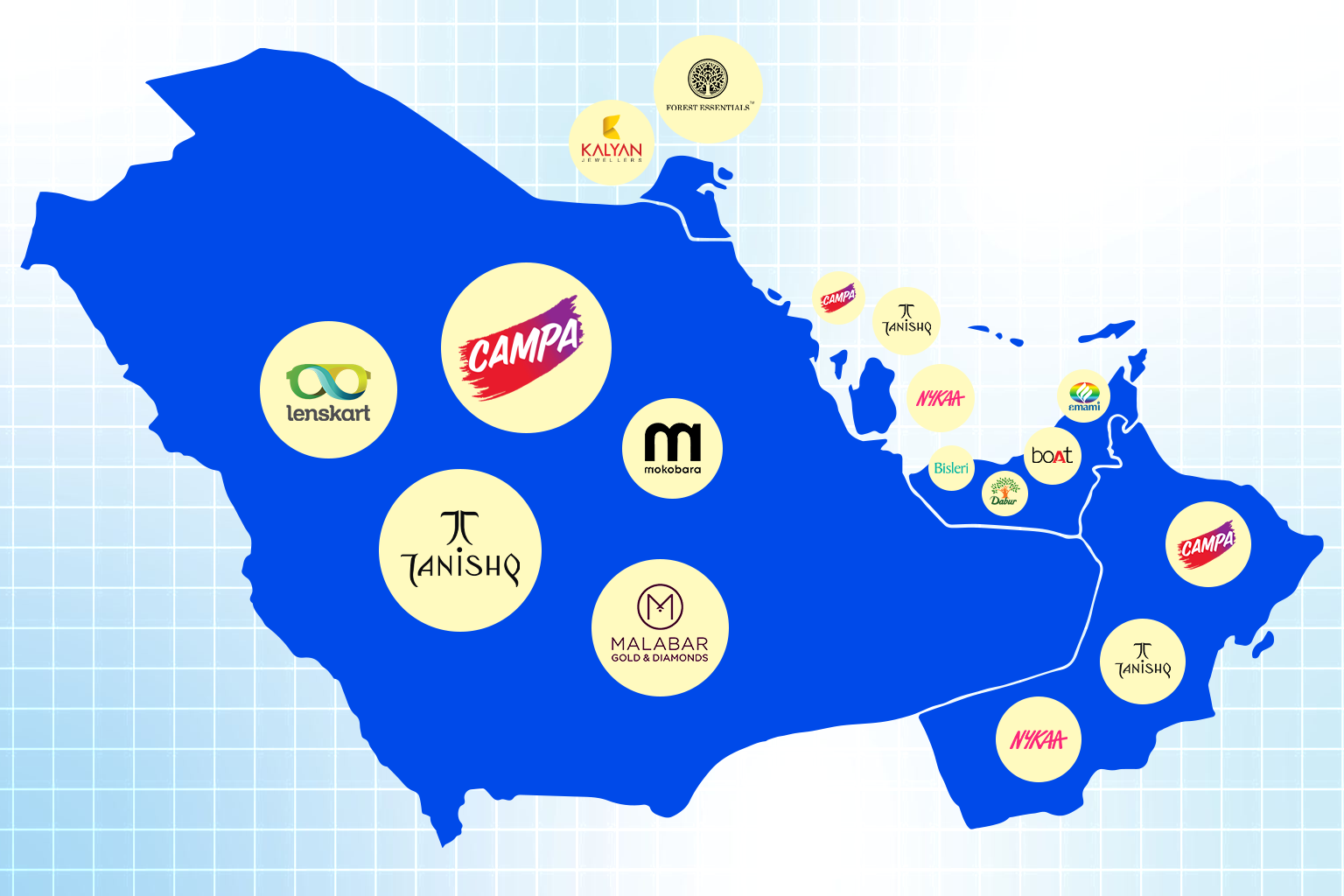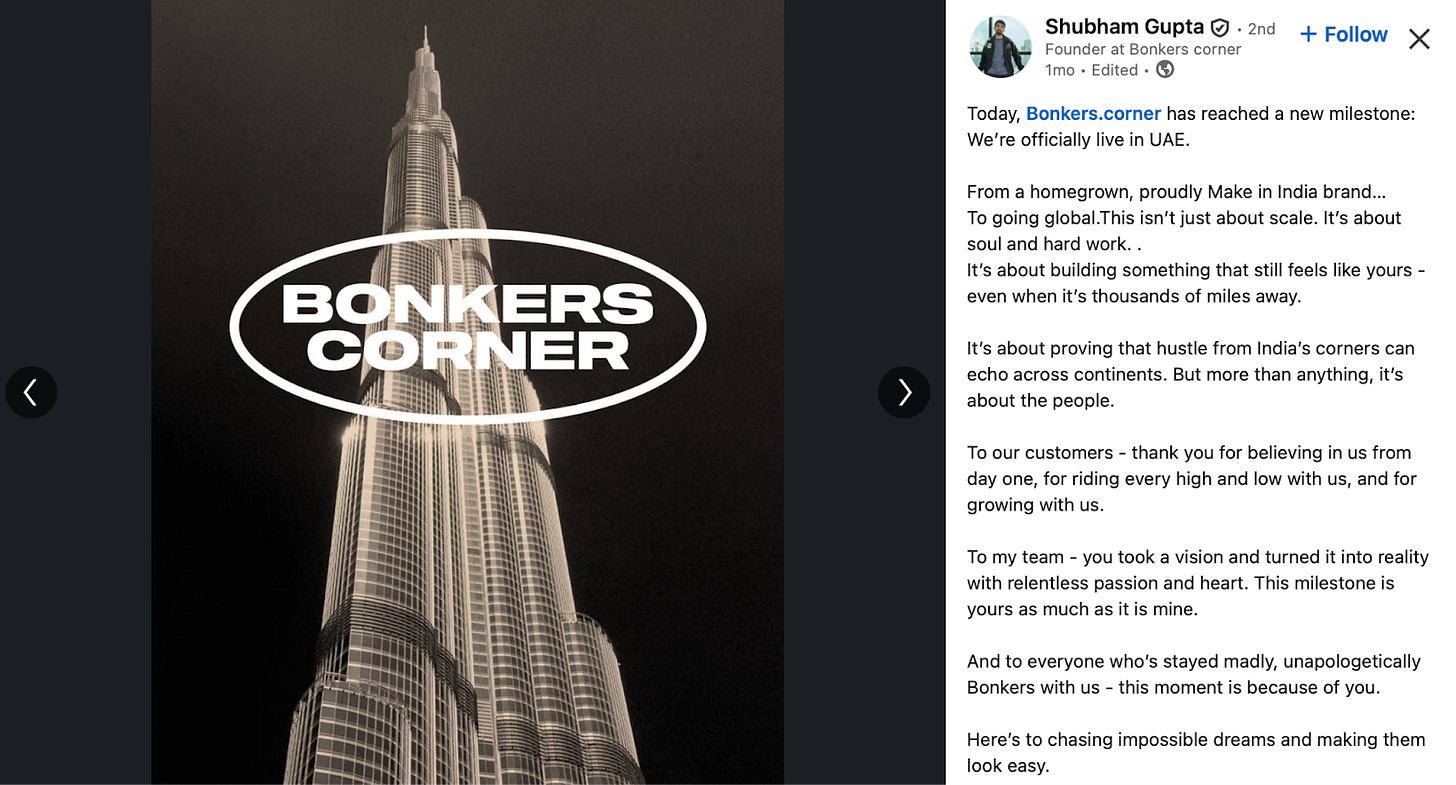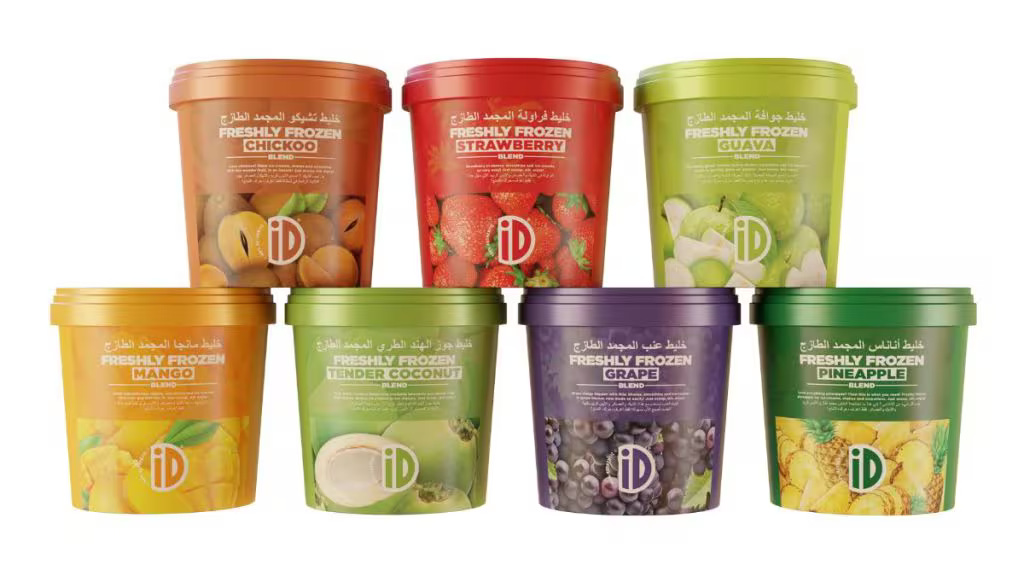Chasing The Gulf Dream
Insights on global ambitions of local brands
Years will pass, and you will have visitings of despair and yet be tortured by hope.
- Mary Shelley, from Frankenstein
Across the ocean yet a stone-throw away, the allure of expanding in the GCC market emerges as a recurring thirst amongst Indian consumer brands. The reasoning is apparently simple: 1) among the highest per capita incomes globally 2) a large and growing expatriate base with strong affinity to Indian products and 3) modern retail infrastructure anchored by malls, e-commerce and organised trade setups. The slides in investor presentations practically write themselves with buzzwords like “Gateway to the Middle East”, “$390B retail market”, “growing at double digit CAGR,” etc. etc.
Despite this headline-grabbing opportunity, the region has proven to be more complex than anticipated. As easy as it is to enter the region…it is equally difficult to establish. What looks like an oasis from the shores of India has left behind a trail of multinationals and homegrown challengers who’ve discovered that margins here are devoured by slotting fees, logistics bottlenecks and price-sensitive customers.
Well, as a founder of a modern accessories brand (~INR 335 cr turnover) expressed his journey -
We haven’t had much action in the topline…it’s decent but not as much as we anticipated. I’ve settled here with (my) family for a short while just to get a better grip on what could work here. Constantly having feet on ground helps and has definitely expanded our understanding of the cultural nuances here on how to sell. It’s been humbling…to say the least. The region has so much to offer yet it’s a difficult market to penetrate. We’re trying to learn from other brands in the region. One learning has been to revise our product line as per European tastes here…which are also aspirational for other ethnicities including Emirates. It doesn’t work for the Russians but that is fine. The Southeast Asian population, even the high-earning part, is super price-sensitive…don’t know if that is a customer segment we want to actively go after here...We’re just getting started.
The latest one to launch in Dubai is Bonkers Corner. P.S. If you haven’t heard of this brand, you should ask a college-going teenager. Founded in 2020 as a digitally native streetwear label, they basically sell Korean pants, crop tops and styles that appeal to Gen Z. The brand is doing >₹100 crore in revenue, supported by ~15 domestic stores and a strong e-commerce presence.
We also spoke to a few other founders/CXOs/CMOs (in the consumer sector) who have been expanding in the region for a few years with varied degrees of success. What stays consistent is the way they narrate their experience - oscillating between hope and despair.
This article is our honest attempt to pass on insights from all these conversations:
Dubai is for optics and Saudi is where the scale is
Dubai is often the first port of call in the Gulf. It’s easy to set up, English is everywhere and the Indian diaspora provides a familiar base. A storefront in Dubai Mall or a listing in Carrefour looks fantastic in investor decks; it's proof that you’ve “gone global.” There is PR value to it. But the actual market is much smaller than it looks. The UAE has just 11 million people(half of Mumbai), with maybe 1.5 million who have meaningful disposable income. Even capturing a slice of that won’t transform a brand’s topline. In fact, those who opt to open a storefront are most probably bearing a loss.
Saudi Arabia is a different story. With more than 32 million people and a growing economy, it holds true scale. By 2028, Saudi and the UAE together will account for nearly 78% of GCC retail but Saudi will drive the lion’s share of absolute volume. That’s why every brand that wants to move beyond optics has to crack Saudi. It means navigating tougher rules, slower approvals and powerful distributor networks.
Few founders treat Dubai as a pilot market, a place to test market fit before scaling across the Gulf. In reality, it functions very differently. Success in Dubai won’t automatically translate to having a PMF in the Gulf.
Diaspora demand is limited
The large Indian community in the Gulf makes the market look like a natural extension of home. And for staples, that logic holds. Rice, atta, masalas, ready-to-cook mixes and idli batter move steadily because they serve a need no one else fills at scale. Brands like Britannia, Dabur, and ID Foods have built healthy businesses on this diaspora foundation.
But diaspora demand only goes so far. If you’re in aspirational categories such as fashion, beauty, personal care, or premium F&B, the scale comes from Emiratis, Arabs, Europeans, Russians, etc.
That’s where many Indian brands stumble. What looks premium in Mumbai feels ordinary in Dubai. Without upgrading design, packaging, and storytelling to global standards, the brand will find it difficult to hack growth.
What is mid-market?
In India, “mass premium” is the sweet spot. A brand that positions itself above the cheapest options but below luxury often captures the fastest growth. But in the Gulf, that middle ground is where most brands die.
The region’s consumers are polarized. At the top end, Emiratis and wealthy expatriates lean heavily into luxury. They want European styling, global brands, and products that signal status. At the bottom end, a huge base of Asian and African expatriates is hyper price-sensitive - they shop for value, promotions, and bulk deals. You’ve got to choose a side.
Upfront burn is high
One of the biggest misconceptions founders carry into the Gulf is that they can replicate their playbook there. The “lean pilot” model is the DNA of India’s startup ecosystem. But in the GCC, the economics and the operating environment make that approach almost impossible.
Even a modest market entry demands a heavy upfront investment. Licenses and company formation costs are significant. Distributor contracts often involve minimum guarantees and lock-ins + shelf-slotting fees in major chains are steep and retailers expect you to fund mandatory promotions to drive footfall. Add logistics, compliance, and working capital tied up in inventory, and the cost of simply running a meaningful PMF test easily crosses ₹6 - 10 crore.
Digital isn’t the savior it looks like either. E-commerce is concentrated in a few large platforms such as Noon, Amazon.ae, Carrefour Online; and access to them sometimes requires going through distributors. Customer acquisition costs are inflated because you’re competing with global giants. And consumers themselves are skeptical of unproven D2C brands; they gravitate to established retailers or big marketplaces where trust and fulfillment are guaranteed.
The feedback loop is equally punishing. Retailers review performance quarterly, distributors resist frequent changes, and even minor packaging or labelling adjustments can trigger new regulatory approvals. That means it often takes 18-24 months before you know if a product is resonating. By then, most early-stage brands have already exhausted their capital. Success does depend on having the runway to survive long feedback cycles and heavy initial burn.
Retailers are gatekeepers
A handful of retail conglomerates control most of the visibility: LuLu runs hypermarkets across the region, Carrefour (Majid Al Futtaim) dominates in the UAE and beyond, Landmark owns a vast fashion and lifestyle portfolio and Apparel Group manages over 75 global brands.
If you aren’t inside one of these ecosystems, you’re effectively invisible. Consumers may want your product but without a slot in LuLu or Carrefour, they won’t even know you exist. And these retailers look for proof of supply chain reliability, depth of SKUs and a willingness to fund promotions and discounts.
Additionally, almost every category is mediated by distributors. They control the supply chain, manage retailer relationships, handle compliance paperwork and in turn decide which products get shelf space. Building trust with B2B partners is critical.
Country-by-country rules
A product registered and approved in Dubai can’t be sold in Saudi without fresh paperwork. Saudi Arabia, for example, requires dual date-labelling (Gregorian and Hijri), halal certifications and local representation for customs clearance. Oman and Kuwait have their own product registration portals, labelling formats, and distributor approval processes. Even Qatar, despite its size, insists on separate registration and packaging norms.
For founders, this means each new market is effectively a fresh project with new approvals, new distributors, and new burn.
UAE is Easy to Enter, Hard to Win
Compared to the complexity of Saudi or the opacity of smaller Gulf states, Dubai in particular looks frictionless. It’s why so many startups begin their international journey here.
But the simplicity of entry often masks the difficulty of survival. Getting the paperwork done is the easy part; building a viable business is the real challenge. Consumers are spoiled for choice, they benchmark every purchase against international brands and are quick to switch if the product or price disappoints.
How companies are thinking around this:
Brand Studio Lifestyle, parent to labels like Tokyo Talkies, Highlander, Vishudh, Ketch, and Locomotive has recently debuted in UAE. It launched three flagship stores in the UAE - one at BurJuman (Dubai) and two in Sharjah (Sahara Centre at ~9,000 sq ft; Mega Mall ~5,000 sq ft) via a partnership with Rapheal Lifestyle. Its plan includes adding seven more ME stores by March 2026.
Highlander and Tokyo Talkies are well-known brands in India, and we expect them to also resonate with the vast Indian diaspora. The market leaders are legacy brands and have their own unique offering. Highlander and Tokyo Talkies stand differentiated in their pricing positioning above Max and below the European fast fashion giants. Further, the styles we have curated specially for the UAE are handpicked to give the consumer an experience of the fashion and quality that the brands are famous for…The market, as I said earlier, is growing rapidly and there is significant headroom for new brands like us to garner market share.
On the other hand, amongst staples, the UAE is ID Fresh’s largest international market after India, accounting for a neat 30% of the company’s overall revenue per available reports. In the region, ID has been constantly innovating beyond its usual product lines of idli/dosa batter and filter coffee decoction.
At iD Fresh Food, we are constantly exploring new ways to address consumer needs using common sense. The product aims to solve the inconvenience of peeling/cutting fruits to make shakes/smoothies and solves the problem of round the year unavailability of some favourite fruits, without compromising on the nutritional aspects.
Ferns N Petals (FNP) had to change the entire product line, and introduce new verticals and catalogues to cater to UAE.
For example, the flowers popularly gifted in the region include tulips, sunflowers, and others in a pastel colour palette. Perfumes or attars are a popular choice of gifts among Emiratis. The Russians, meanwhile, believe in gifting flowers in odd numbers.
Every now and then, well-funded D2C startups from India beyond Series A keep launching their expedition to the region. Case in point - Mokobara. Among the mix are 100cr or sub 100cr revenue brands who try to jump the fence in aspirations of an oasis. Actress Chahatt Khanna-led luxury sleepwear brand Ammarzo is one of them with a recent launch on Noon and Namshi.
And then there are the bigwigs -
Titan Company Limited is set to acquire a 67% stake in Damas jewellery business in GCC countries at the enterprise value of AED 1,038 million. With this, Titan is on the path to acquire the balance 33% by the end of 2029. With a network presence of 146 stores across the 6 GCC countries, Damas today, houses a rich and curated portfolio of in-house collections alongside prestigious international labels. It is already well-established within the region.
C.K. Venkataraman, Managing Director of Titan, said:
"After successfully establishing Tanishq in the GCC countries and the USA, our ambition for a global jewellery play is moving to the next stage. With the Damas acquisition, Titan Company is stepping out from its diaspora focus into other nationalities and ethnicities.
Alongside, Reliance Consumer Products Limited (RCPL)-
Having acquired Campa Cola in 2022 and reintroducing it to the Indian market in 2023 is now expanding overseas. This cult favourite will be launched in the UAE in partnership with Agthia Group, a leading food and beverage company in the region.
I hope the pattern is visible, well-capitalised players partner with powerful distributors, localise and innovate for the market-tastes while smaller players try to crack the digital channel while having a bit of offline presence. While staples or Indian-oriented products get the leverage of diaspora, aspirational/luxury brands need to reinvent their product lines.
To sum it up
The GCC does have water in the desert although it lies much further away than it appears. The opportunity is real but the cost of accessing it often dwarfs the early-stage capacity of challenger brands. Without realistic GTM planning, what looks like an oasis can quickly become a mirage.
In the next post of this series, we’ll dig into how some of the consumer brands have fared in the region and how they have financed their expansion.






